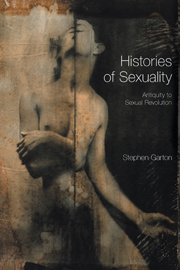Book contents
- Frontmatter
- Dedication
- Contents
- Preface
- 1 Writing Sexual History
- 2 Rule of the Phallus
- 3 Sexual Austerity
- 4 Christian Friendships
- 5 Making Heterosexuality
- 6 Victorianism
- 7 Dominance and Desire
- 8 Feminism and Friendship
- 9 Imagining Perversion
- 10 Normalizing Sexuality
- 11 Sexual Revolution
- Epilogue
- Endnotes
- Select Bibliography
- Index
3 - Sexual Austerity
- Frontmatter
- Dedication
- Contents
- Preface
- 1 Writing Sexual History
- 2 Rule of the Phallus
- 3 Sexual Austerity
- 4 Christian Friendships
- 5 Making Heterosexuality
- 6 Victorianism
- 7 Dominance and Desire
- 8 Feminism and Friendship
- 9 Imagining Perversion
- 10 Normalizing Sexuality
- 11 Sexual Revolution
- Epilogue
- Endnotes
- Select Bibliography
- Index
Summary
According to the first-century BCE Roman geographer Strabo, the annual religious festival at Canopus in Roman Egypt was marked by singing, dancing, devotional duties and sexual licentiousness. There may have been many Greek and Roman philosophers, religious authorities and doctors who warned of the perils of sexual excess, counselling the virtues of moderation, but, as ‘Canoptic life’ suggested, religion and sexual licence were not entirely incompatible. Four hundred years later Christianity had wrought a dramatic shift in the relationship between sex and religion. In the Eastern Church influential founders such as John Chrysostom preached an ideal of Heaven ‘uninflamed by any lustfulness…[in which] there was no desire for sexual intercourse’. In the Western Church, St Augustine, one of Christianity's most important Fathers, preached the doctrine of ‘original sin’, clearly linking sex to ‘man's’ fall from grace. While St Augustine was prepared to sanction marriage as an acceptable relationship, sex within marriage was only permissible for the purposes of procreation.
St Augustine and other early Church Fathers struggled to overcome the clash between their belief in the necessity to transcend bodily desires and the need for sex to perpetuate the Christian flock. While affirming marriage they at the same time espoused chastity as the highest spiritual ideal. For St Augustine, a good Christian loved the ‘woman that God created…while he hates the corruptible and mortal relationship and marital intercourse’.
- Type
- Chapter
- Information
- Histories of SexualityAntiquity to Sexual Revolution, pp. 48 - 63Publisher: Acumen PublishingPrint publication year: 2004



